As a warm-up, here are a couple of links for background info. The first is a blog post on legends of South Africa that includes the story about the "table cloth" of Table Mountain, and the second story is about the Hexrivierberge. The second link is a satellite view of the Hexrivierberge. If you zoom out to where you can see Ceres you can get an idea of where we were. Look for the elbow bend of the mountain chain to the southeast of Ceres and you'll see a large reservoir (dam) at the end of a string of smaller ones. There's a small patch of forest on the southeast corner of that dam. That's where we parked our vehicles and began the climb. We hiked southeast of that point to the escarpment between Milner Ridge Peak and Milner Peak.
My companions for this weekend were Adam and Leeana Harrower, Dennis and Gigi Laidler and Esprit Heestand. Adam had sent me a picture of an unusual Hyobanche he had collected in this area during a trip in 2004. He also sent me a specimen to examine and from which to extract DNA. Those preliminary analyses were enough to convince me that the Hyobanche up here is a new species and I was very keen to go and look for it. It didn't take a lot of arm twisting to convince my companions that a weekend backpacking trip to the mountains was worth the effort. Dennis posted an entry about this weekend on his blog, too. He has all the names of the mountains and some more detailed info than I can provide, plus his pictures are lekker (very nice).
 We had planned on parking near a dam on a farm that has served as a base for many previous Kirstenbosch expeditions. What we were not prepared for was to run into a huge crowd of people celebrating some sports day events, including mountain bike races, foot races, horseback riding, camping, and the like. The farm was swarming with people and activities. We thought this might prove to be a hassle for the backpacking trip, but we soon discovered that we were the only people crazy enough to begin a hike of this nature in 30°C weather.
We had planned on parking near a dam on a farm that has served as a base for many previous Kirstenbosch expeditions. What we were not prepared for was to run into a huge crowd of people celebrating some sports day events, including mountain bike races, foot races, horseback riding, camping, and the like. The farm was swarming with people and activities. We thought this might prove to be a hassle for the backpacking trip, but we soon discovered that we were the only people crazy enough to begin a hike of this nature in 30°C weather.
Arriving at the main farm compound we found that the road had been converted to a race course, complete with corner marshalls.

This must have been a weekend-long event given all the campers parked on the grounds. You can see the Kirstenbosch bakkie in the foreground.

Adam and Dennis went to look for the farmer to let him know we'd be parking by the dam. The person they talked to thought we were a bit daft to be climbing in this heat, but he wished us well.

The road to the dam was pretty dusty and I felt sorry for the racers having to eat dirt. We did collect resentful looks from some of them.

I don't know how many racers there were but we encountered quite a few. You can see the mountains we're going to climb in this view. We're headed toward the middle, left ridge of this picture.

Sorry guys - breathe carefully.

There's a patch of pine trees next to the dam that provides some shelter for the cars.
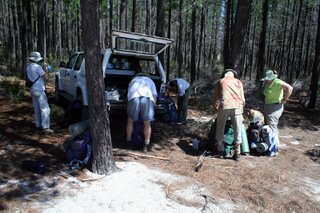
The first order of business was to prepare the backpacks and to get organized for hiking. The only tick I found was at this site.
 We were hiking up the "easy" side of the Hexrivierberge. These are fault block mountains that have been popped out of the ground. One side has sheer dropoffs and cliffs, the other is a long, "gentle" slope up to an escarpment. That long slope includes a series of steep steps where the real climbing takes place. In between the steps are long , sloping flats.
We were hiking up the "easy" side of the Hexrivierberge. These are fault block mountains that have been popped out of the ground. One side has sheer dropoffs and cliffs, the other is a long, "gentle" slope up to an escarpment. That long slope includes a series of steep steps where the real climbing takes place. In between the steps are long , sloping flats.The vegetation changes with each step and the increasing elevation.

We started off in a dry scrub dominated by protea shrubs. There was just a short stretch of trail near the dam, but this disappeared after the first rock band. The rest of the trip was sans trails.
Adam hiked in shorts through the "painbos." Sunburn combined with scratchy plants is no fun, I think.

We took a breather after the first rock band. Esprit and Gigi are looking at the view.

It sure seemed like we climbed a lot higher than this, but all of the vistas were deceptive. No matter how high we climbed, the upper slopes seemed out of reach and it didn't look like we were making much progress up from the dams.

Here's one of those sloping flats adjacent to the next rock band to climb. The area is sufficiently dry and rocky to keep the vegetation from filling in too densely, which makes hiking through here easier without a trail than it would otherwise be.
The early part of this climb was pretty hot. The temperature eased as we went higher and the afternoon progressed.

One of the things that impressed me was the changing vegetation with increasing elevation. The color schemes changed as well. On the lower dry slopes the color dominance was in shades of gray and green. Up above the color scheme was more in the reds and bronzes. This was due to the prevalence of scrubby shrubs below and restios and ericas above.

There was a lot of picture taking going on all around. I took 500 images during these two days.

I really enjoyed all the views in the area. This slope is about where we lost the sounds of civilization. There was a lot of noise coming up from below that was associated with the big sports day events, including an annoying radio station blaring from the swimming activities at the dam.

That little knoll on the left became an important landmark in terms of heading in the right direction during our descent the next day. We followed a long spur to the upper slopes - a good choice in terms of the topography of the area.

Another rest break after a section of climbing.

The upper slopes are finally in view after this bit of climbing. It's still a long way off - about four or five hours of hiking to where we made camp.

Dennis was always ahead scouting out the easy routes to hike or climb. Thanks, Dennis!

Adam and Leeana enjoying a break.
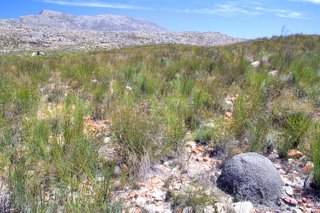
Making mountains of ant hills?
I always like seeing ant hills during a Hyobanche hunt because that improves my chances of seeing Hyobanche. As I mentioned in earlier posts, ants seem to be very important to Hyobanche and vice versa.

I used a polarizing filter on my Canon EOS Rebel XT. It sure brings out the blues in the sky nicely. You can start to see the shift in color schemes at this point. The vegetation changes from predominantly shrubs to restios, sedges and smaller herbaceous plants. There are also a lot of plants in the protea family up here.

There's our return landmark on the far right. That's about where we took our last break. The scale of distance is very hard to gauge.
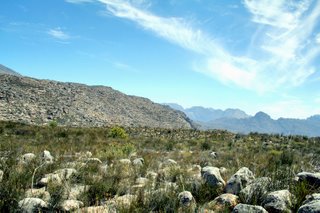
It's interesting to look at the distant slope and think that they're solid rocks, but the vegetation is definitely there as you'll see from the pictures.
 Here's a panorama view - sorry about the effects of the polarizing filter. Now that I know how to do panoramas, I'll remember to not use the filter for these images in the future. Our base camp area is to the left of cleft on the left-hand third of the image.
Here's a panorama view - sorry about the effects of the polarizing filter. Now that I know how to do panoramas, I'll remember to not use the filter for these images in the future. Our base camp area is to the left of cleft on the left-hand third of the image.
The upper slopes have a lot of rock scrambles like the one in this and the next image.

Each area has uniqueness in terms of the plants that you find. The different aspects relative to the sun, water availability, and amount of accumulated soils dictate the diversity of plant species.

Esprit, Dennis and Adam.

Leeana and Gigi.

Here's a small Pelargonium, or maybe this is another genus in Geraniaceae. I'm not quite sure.
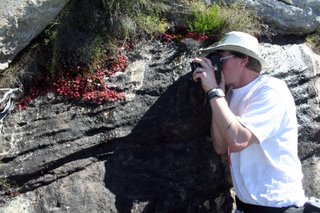
Adam photographing a Drosera (sundew) garden.

These carnivorous plants are hard to photograph. The flowers are on such spindly stems that it's hard to get a sufficient depth of field to have the flowers and basal rosettes simultaneously in focus.

Another climb, another break - this time for lunch. Dennis is already up on the rock where we sat to eat.

Dennis and Gigi enjoying the lunchtime view.
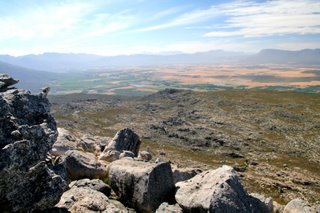
Here's the view. The dam where we parked is now out of sight and it seems as if we've made some progress in gaining elevation. We had gained almost 2000 feet of elevation by this point.
 On the flats above the spot where we stopped for lunch, the dominant vegetation changed to sedges and restios. The bronze color effect is from the developing fruits at the tips of the stems. This color changed characteristics depending on the position of the sun in the sky. During late afternoon and early morning, the color was the most vibrant. With the sun overhead, the color scheme was much more subdued.
On the flats above the spot where we stopped for lunch, the dominant vegetation changed to sedges and restios. The bronze color effect is from the developing fruits at the tips of the stems. This color changed characteristics depending on the position of the sun in the sky. During late afternoon and early morning, the color was the most vibrant. With the sun overhead, the color scheme was much more subdued. Time to check the topo map and make sure we're heading for the correct "flat" for making base camp. Adam had camped up here in 2004 and remembered a great spot for pitching tents. We used the GPS reading from his previous collecting site together with the topo map as a guide for navigating. It's getting pretty late in the day and it's always better to make camp before sunset.
Time to check the topo map and make sure we're heading for the correct "flat" for making base camp. Adam had camped up here in 2004 and remembered a great spot for pitching tents. We used the GPS reading from his previous collecting site together with the topo map as a guide for navigating. It's getting pretty late in the day and it's always better to make camp before sunset.
I loved the lighting during these last hours of the day. The landscape became somewhat surreal in terms of the hues. I wish I could paint in 2D - I'd love to capture these scenes on canvas.

Lots of climbing still to do. I like these kinds of rock scrambles, but it's a bit more of a challenge with a large pack on one's back.

Ahhhhhh - the first mountain water of the hike. We had just about gone through our initial stores of water and so this was very refreshing after the hot slog up the slopes. The water has a brown tint from the fynbos vegetation, but it's as pure and clean as you'll ever sample. It tastes wonderful, cold and refreshing. We followed this stream all the way up to our campsite.

On the upper slopes, the sedge/restio mats become even thicker and taller as the water availability increases. In some places in the alpine we walked across boggy areas on these mats of vegetation. Hiking poles often plunge through the mat, making for a bit of excitement. You can hear the water running beneath the vegetation.

The landscape here is dominated by large boulders and flats of vegetation.

The diversity of Erica species is staggering. There are more than 650 species of Erica in the Western Cape.

Nope, we're not quite to our campsite as of yet even though this area is suitably flat.

Ok, so now we've made some progress up from the valley below. Ceres is off the left margin of the image's left edge.

Nice rock. No snakes spotted, though.

Getting close - the campsite will be off to the upper left, not too far from this beautiful mountain stream pool.

Now you can see Milner Peak at the left and Milner Ridge and Milner Ridge Peak, Shales Peak and Buffels Peak, left to right.

I love the view from here looking toward the west.

I mentioned the diversity of Erica species already, but there's also an incredible diversity of species in the Protea family, including this Queen Protea.

The flower head is about 8 inches across.

More lovely rock, wonderful to climb.

Here's our campsite. Milner Peak is the backdrop. To the right is Milner Ridge and Milner Ridge Peak. We're camping below Shales Peak and Buffels Peak.
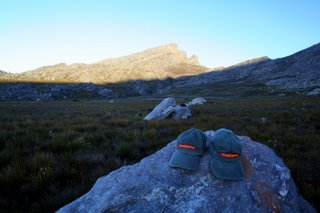
An opportunity for a Woodcentral Sightings pic.

We used Dennis and Gigi's tents. These are a little more complicated to assemble than current backpacking tents, so we let them handle the task since they knew how all the poles and pegs were supposed to be organized.

As the sun went below the horizon, the temperature began to drop pretty quickly.

Ahhhhhh, relief. It felt so good to get my boots off and change into more comfortable Tevas.

The second tent going up.

Slide tab A into slot B . . . . or something like that.

How many hikers does it take to assemble a tent?

This one has to be worked from the inside as well as the outside.
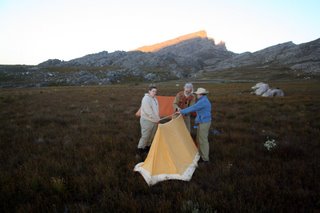
Nearly there - just before the sun sets. The last rays of the day are on Milner Peak.
 Nice and cozy. Adam and Leeana slept out under the stars as did Esprit, just for the experience. She awoke with the comment, "I thought Africa was supposed to be hot!"
Nice and cozy. Adam and Leeana slept out under the stars as did Esprit, just for the experience. She awoke with the comment, "I thought Africa was supposed to be hot!"I was quite comfortable in the tent, a little cold at one point, but donning another layer solved that. I couldn't do much about the vegetation tuffs sticking me in the wrong spot, but not a problem - roll over and sleep some more fixes just about anything when you're tired.
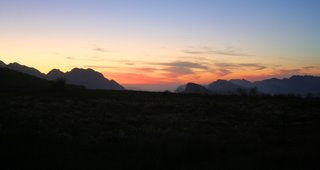
We fixed a late supper after sunset - noodles and such, hot chocolate, lots of warmer uppers. Yummmmm.
The stars were beautiful and we could see the milky way, the clouds of Magellan, and many constellations. It was definitely not Ohio!

I was the first one up on Sunday morning. I awoke with the sunrise and was immediately ready to get a start on the day.

The tents blend in with the landscape in this early morning light.

I walked down to the stream to wash and get some water. It was cold!!!!

Restio inflorescences - probably a species of Elegia.

I don't know this plant name, but it's beautiful.

Another Erica.
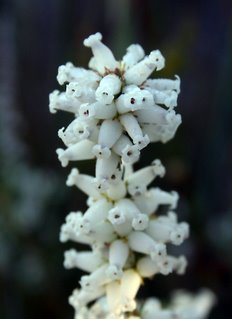
Very lovely. . .

The mist on the mountain tops is also very nice.

Oh, good, everyone is getting up at last.

Except for Esprit who was trying to get warm. We convinced her she would be much warmer in the sun than she was lying there in the shade.

Gigi's up now.

And so was this spider who wanted to hitch a ride on one of the packs.
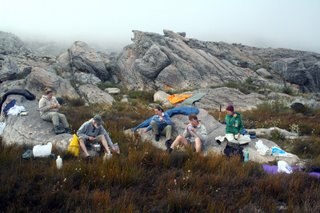
Breakfast on the rocks.

My socks left out to dry while we hiked up to the ridge.
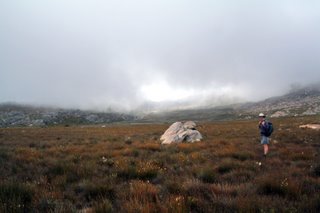
We started off with a mist hiding the ridge. It was so nice to head up without all the gear. Dennis and Adam carried day packs, but the rest of us were free of the weight. Wow, what a difference that makes!

We couldn't really see how far we had to climb to get to the previous collecting site, which was probably a good thing. It was very beautiful with the mist and the clouds parting every once-in-awhile to let some rays of sunshine strike the rock.

Without a pack, I felt much more like stopping to take photos of plants and such. This is a ground flowering protea. Most of the ones that flower at ground level are probably pollinated by rodents.

Here's a view of the whole plant.

There was a lot of this going on. . .

for taking photos, of course.

How can you resist taking photos of beautiful plants such as this white morph of the Queen Protea?

Or the regular morph, for that matter?

These plants take your breath away when you come upon them. They just pop up out of nowhere as you come across a boulder.

I think this was my favorite Erica of the entire weekend.

Here's another plant of the same species.

The diversity of Erica species was amazing.

Here's a good view of mountain fynbos habitat. As we climbed higher the vegetation changed to alpine fynbos.
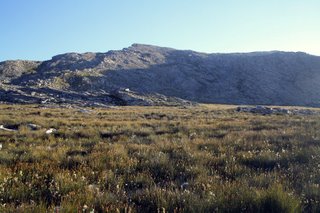
There were a few more of these sloping flats before we reached the last bit of mountain to climb.

This is the last bit of flats before the final climb. If you look at the enlarged picture you might be able to find the orange dots near the center that mark the tents of our campsite.

Dennis, as usual, climbed ahead to scope out the route.
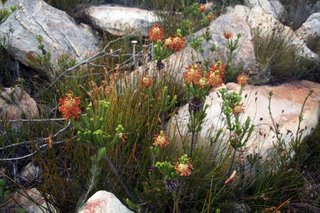
I'm not sure if this is also an Erica.

I hope one of my companions can tell me what this plant species is.

It hangs onto its seeds until a fire. Adam released them from the plant.
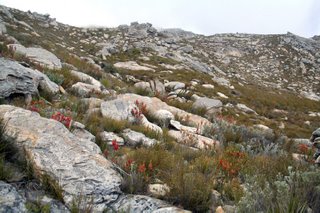
It blends in with the background coloring, that's for sure.

Another species of Erica. I don't know how many that makes since I lost count a long time ago.

We finally reached the right kind of habitat with the right species of potential host plants for Hyobanche. At this point onwards everyone had their eyes on the ground searching for Hyobanche.

The more eyes on the ground, the better the chances of finding our quarry.

A view back towards where we climbed. Can you see our base camp?

Another ground-hugging protea.

Close-up of the inflorescence. Each "flower" is actually a collection of small, individual flowers.

Not a trivial climb, all the while looking for Hyobanche.

Adam, searching in all earnestness. I think he felt some pressure to have a successful hunt, even though I assured him it wouldn't be unusual to not see Hyobanche come up from year-to-year. These parasitic plants don't need to be above ground except to flower, and that's not really necessary each year.
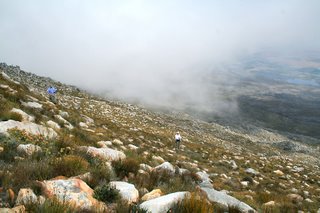
This gives you a perspective on that final slope.

You keep climbing until you reach the edge of the escarpment and then you look over the edge to a couple of thousand feet drop. Wow, it's impressive. You see the front face of Milner Peak just coming out of the mist in this picture.

This is where Adam collected the plant in 2004. We spent a very long time carefully searching this slope, but we couldn't find any sign of Hyobanche.

We did see a lot of interesting plants, though, including this nice clump of mesembs.

Close-up of the same.

Still searching for Hyobanche. The mist is starting to lift in the morning sun.
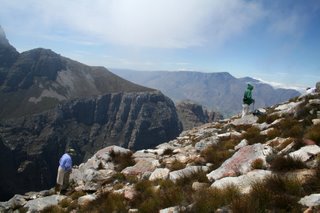
Nice view, eh?

Dennis helped me arrange another WC sightings pic.

Here's my version of the composition.

I walked/climbed around the corner of the outcrop we were on to look on the leeward side of the slope. The view was pretty inspiring. Out of the wind it was much warmer on this side. I surprised a snake basking in the sun. I didn't catch a good look at it, but it's size and coloration were about right for a berg adder.
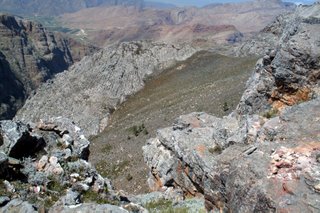
This is the view over the edge.

And an attempt at a composite panorama.

You can see the cape fold pattern in the sandstone on this outcrop.

I really enjoyed this view. I'm glad we came up the "easy" side rather than the front face of this mountain range.

Another ground-hugging protea on this side of the rocks.
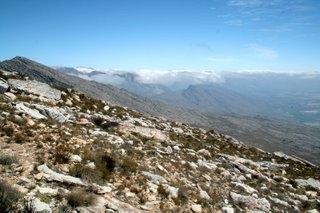 This is the view along Milner Ridge. After spending a lot of time at the previous collection site, we decided we should head back down to camp to pack it up and head back to the cars. We were well on our way down when Adam called to us, "I found one!" My immediate reaction was, "Hurray!" My second reaction upon seeing how far I'd have to reclimb was, "Shit!" It was well worth the effort, though.
This is the view along Milner Ridge. After spending a lot of time at the previous collection site, we decided we should head back down to camp to pack it up and head back to the cars. We were well on our way down when Adam called to us, "I found one!" My immediate reaction was, "Hurray!" My second reaction upon seeing how far I'd have to reclimb was, "Shit!" It was well worth the effort, though.
I have no idea how Adam saw this individual of Hyobanche. It's not even flowering as of yet; the inflorescence is just emerging from the ground. Can you spot it? No?
At the lower center edge of the picture you can see a vertical slab of rock. The Hyobanche plant is just to the right of that. Adam was a miracle worker that morning. Nicely done!

Here's a closer look,

and a detail. This plant is definitely different than Hyobanche atropurpurea. The primary differences are in the hairs, the inflorescence stem bracts, and flower shape and color. You can't see that here, but I have the original photos for comparison and I compared this specimen to a H. atropurpurea I had back at the Kirstenbosch apartment. Looks pretty definite to me at this stage.

We were about 3 weeks ahead of peak flower season for this location so I undertook the excavation very carefully. I'd hate to lose the host root connections since this is my one and only chance to sample this for a long while.

I didn't want to take any chances so I pretty much relied on my fingers and the paint brush.

Looks pretty promising. I had to be especially careful at this stage.

Success! I can't wait to determine what the host plants are.

Habitat pic to show the terrain and vegetation where this new species occurs.

Adam and I are pointing to the spot where I just dug up the Hyobanche rhizome. Thanks, Adam! You're a champion!
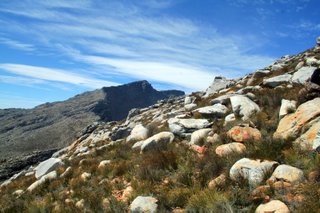
Another habitat shot with Milner Peak in the background.

Milner Ridge as it looked during our descent.

The flats above our campsite.

It's farther back to camp than it seemed going up the ridge, but that's probably because it's much harder going downhill than up.

Panorama of the flats near our campsite.

Back to fresh water and a good, long drink.

It's always good to have a source of water nearby in the mountains. This stream kept us company for a long ways down the mountain during our descent.
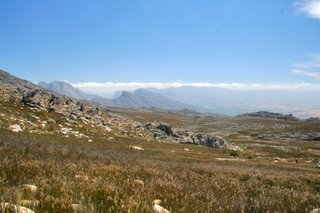
Just about there now.

Back to camp at last.

Time for a brief rest, then pack it all up and move on out.
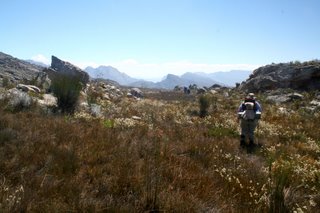
Now we're fully loaded and racing the clock to be down off the mountain before sunset.

The easy parts are on the stretches of sloping flats.

Some of these areas are a bit challenging in terms of the loose rock that tries to twist ankles.

Lunchtime again - this time at that lovely pool we encountered on the ascent. Dennis and Adam took swims. I don't know how they handled the cold, but they seemed pretty content to take a dip.

Another Drosera garden on one of the seeps near the stream. I always felt bad while walking through the seeps whenever I had to step on this kind of mat.

A refreshing break in the shade next to the stream. Sorry for the photo - Dennis didn't quite have the camera set right. You can see a better version on his blog.

Palmiet in the stream where we rested.

A view upslope where we were a little while ago.

The last flat on the spur before the final descent.

We're nearly there - the cars are in sight and we just made it back before sunset.
It was an incredible weekend! I thoroughly enjoyed the trip and having spent time with my friends.











3 comments:
What a lovely armchair hike, only made better with the thrill of finding the elusive Hyobanche!
Additionally, it must feel great to have a made the right choice of cameras -- very nice photos!
Well, I feel as if I should go dry my socks -- thanks for the walk-about.
e
Thanks for coming along, e.
You have some fantastic plant pictures. If you want them identified put them on http://za.ispot.org.za (South African species only please) and there are lots of experts and amateurs there who will identify them in a jiffy, and probably throw in some exciting ecology at the same time.
Post a Comment